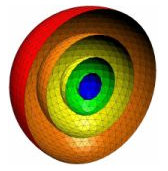Surface Equivalence Principle (SEP)
The surface equivalence principle (SEP) introduces equivalent electric and magnetic currents on the surface of a closed dielectric body. The surface of such bodies can be arbitrarily shaped and is discretised using triangles.
The surface equivalence principle (SEP) is the default method for solving dielectric materials when using the method of moments. The SEP introduces equivalent electric and magnetic currents on the boundary of the dielectric body (opposed to only using only equivalent electric currents on a perfectly electric conducting body).
The SEP can model homogeneous dielectric bodies efficiently, but becomes inefficient when the material is inhomogeneous, as is the case when modelling biological tissue or multiple thin layers of dielectric.
Feko includes other solution methods for efficient treatment of inhomogeneous dielectric structures. These include volume equivalence principle, the finite element method and support for planar multi-layered media.

Figure 1. An example of a layered dielectric body consisting of closed bounding surfaces.